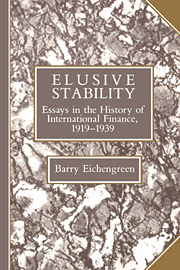Book contents
- Frontmatter
- Contents
- List of tables
- List of figures
- Acknowledgments
- 1 Introduction
- 2 Real exchange rate behavior under alternative international monetary regimes
- 3 Understanding 1921–1927: inflation and economic recovery in the 1920s
- 4 Bank Rate policy under the interwar gold standard
- 5 The Bank of France and the sterilization of gold, 1926–1932
- 6 International policy coordination in historical perspective: a view from the interwar years
- 7 The economic consequences of the franc Poincaré
- 8 Sterling and the tariff, 1929–1932
- 9 Exchange rates and economic recovery in the 1930s
- 10 The gold-exchange standard and the Great Depression
- 11 Hegemonic stability theories of the international monetary system
- References
- Index
5 - The Bank of France and the sterilization of gold, 1926–1932
Published online by Cambridge University Press: 21 March 2010
- Frontmatter
- Contents
- List of tables
- List of figures
- Acknowledgments
- 1 Introduction
- 2 Real exchange rate behavior under alternative international monetary regimes
- 3 Understanding 1921–1927: inflation and economic recovery in the 1920s
- 4 Bank Rate policy under the interwar gold standard
- 5 The Bank of France and the sterilization of gold, 1926–1932
- 6 International policy coordination in historical perspective: a view from the interwar years
- 7 The economic consequences of the franc Poincaré
- 8 Sterling and the tariff, 1929–1932
- 9 Exchange rates and economic recovery in the 1930s
- 10 The gold-exchange standard and the Great Depression
- 11 Hegemonic stability theories of the international monetary system
- References
- Index
Summary
The malfunctioning of the interwar gold standard is frequently given much of the credit, or more precisely the blame, for the instability of the world economy in the late 1920s and early 1930s. Accounts of the period typically attribute the monetary standard's unsatisfactory performance to the mismanagement of gold reserves. Due to misguided policy, it is alleged, gold stocks proved insufficient in quantity and elasticity for the system's smooth operation. By reestablishing prewar parities and hence prewar gold prices, governments unwisely depressed the nominal value of metallic reserves. The low level of reserves relative to incomes limited monetary growth, promoted deflation, and complicated the efforts of central banks to maintain convertibility. These difficulties were exacerbated by the uneven international distribution of the available gold. By 1931 the United States and France possessed between them more than 60% of the world's metallic reserves. Their propensity to accumulate gold intensified deflationary pressures operating abroad. With downward rigidity of costs impeding adjustment to these pressures, the shortage of gold caused falling output and employment rather than falling wages and prices. The unemployment which resulted created budgetary difficulties for the authorities, ultimately undermining their ability to maintain fixed parities.
The practice by central banks of offsetting the effects of reserve flows – “sterilization” as it was known in England, “neutralisation” as it was known in France – was both a cause and a consequence of this situation.
- Type
- Chapter
- Information
- Elusive StabilityEssays in the History of International Finance, 1919–1939, pp. 83 - 112Publisher: Cambridge University PressPrint publication year: 1990

